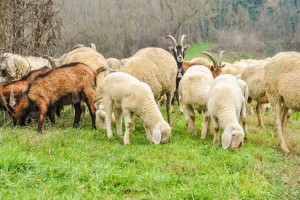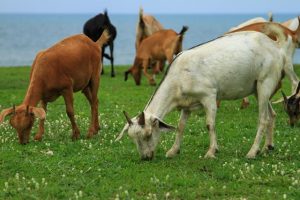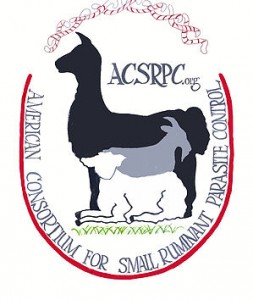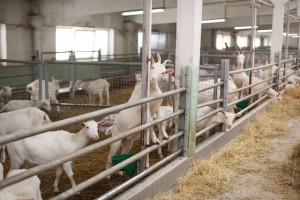Sorry, but the selected Zotpress account can't be found.
Goat Diseases
Parasitic Gastroenteritis in Goats
Goats are particularly susceptible to Haemonchus contortus (Barbers pole worm), but as this specific gut worm does not conform to the same characteristics as other gut roundworms, it has a whole page dedicated to it. Click here to learn more.
Goats differ in their immunological response and have different feeding behaviours compared to sheep and cattle therefore a small summary specific to PGE in goats is found below.
How do goats get worms?
The adult worms reside in the gut and the females lay thousands of eggs which are passed out with faeces onto the pasture. Under suitable climatic conditions these eggs hatch and larva will emerge and reside on the pasture until ingested by a goat, and then will migrate to the gut, where they develop into adult worms. The full lifecycle is explained in more detail on the main Parasitic Gastroenteritis in Ruminants page.
What are the main clinical signs to look out for?
- Reduce growth and weight loss caused by loss in appetite and poor gut function
- Reduced milk production
- Reduced and poor quality fibre growth
- Diarrhoea
- Anaemia
- Sudden death (taken from Harwood, 2006)
What is different about parasitic gastroenteritis in goats?
Unlike sheep and cattle goats do not develop strong immunity to gut worms. Under normal grazing conditions goats have been shown to be more severely infected than sheep, with much higher burdens and more damage to the gut, and this is due to their inferior ability to elicit an immune response (Torres-Acosta and Hoste, 2008). Consequently, in rangeland grazing (extensive grazing) sheep were found to be more infected than goats, and this is attributed to the goats feeding behaviour in which they prefer to browse rather than graze.
Browsing behaviour of goats
Goats limit contact with infective larvae due to their characteristic feeding behaviour. They are natural browsers eating shrubs and plants as opposed to sheep which primarily graze from the ground. This distinct feeding behaviour should be exploited in goats as worms eggs that have been passed with dung, will hatch on the ground and the microscopic larvae are only capable of migrating short distances up the proximate pasture, and the physical structure of some plant and forage species (e.g., height, spines, and thorns) will inhibit this migration, making them safer for consumption.

Goats are much more susceptible to parasitic gastroenteritis (PGE) than sheep and therefore mixed or co-grazing is NOT recommended.
Control and Prevention of Worms in Goats
Strategies for controlling worms in goats
A review written by a team if scientists in Australia evaluated the current ‘Toolbox’ of parasite control measures goat farmers can employ (Kearney et al., 2016). This review is directed at Haemonchus, nevertheless some of the strategies are relevant to general parasite control implementation. The ‘Toolbox’ consists of the following:
-
Immunonutrition
The term ‘Immunonutrition’ refers to the use of nutrition to boost immunity (Kearney et al., 2016). There are many published studies which demonstrate a direct relationship between nutrition and immunity in small ruminants. Research shows that by improving nutrition the immune response (host resistance) and the ability to maintain production during a high parasitic burden (resilience) also improves. A consequence of gut worm pathology is disruptions in protein absorption and metabolism, and retention of other minerals, hence the target nutrient is often protein. For example, a high protein diet fed to West African Dwarf does increased resilience (better weight gain, body condition, pregnancy and kidding/lactation performance) and enabled the reproducing does to better cope with some of the clinical consequences of parasitism such as reduced feed intake and GI symptoms (Nnandi et al., 2009).
Many studies has shown that goats respond to supplementary feeding with improvement in resilience over resistance, and this is attributed to the acknowledged lower aptitude of goats to develop an effective immune response against gut worms (Kearney et al., 2016).
More about nutrition and PGE can be found here.
-
Bioactive forages and plant secondary metabolites
There are a myriad of active compounds within plants and the utilisation of forages containing active compounds has an important role to play in animal health, particularly goats (Kearney et al., 2016). Many plants have been suggested as having anthelmintic properties, although many have not stood up against rigorous scientific testing. Tannins have been under intensive scrutiny and are generally known to have anthelmintic, antibiotic, antiseptic and antifungal properties. However, high concentrations of condensed tannins reduce feed digestibility, feed intake and consequently lower production. Tannins affect dietary protein availability, inactivate digestive enzymes and irritate the GI tract (Kearney et al., 2016).
Chicory has shown both anthelmintic activity under both in vitro and in vivo experimental conditions, and reduction of the development/survival/migration of larvae due to sward structure (Marley et al., 2006).
Learn more about pasture composition and PGE here.
-
Copper Oxide Wire Particles (COWP) and Haemonchosis in Goats
Copper oxide wire particles (COWPs) are copper boluses used by farmers to treat copper deficiency in cattle. They release copper wire particles throughout the GI tract, and raise copper concentrations in the abomasum. COWPs have demonstrated high anthelmintic activity against Haemonchus, but nil effects on Teladorsagia and Trichostrongylus, under both natural and experimental conditions (Chartier et al., 2000a and 2000b). COWPs create an unfavourable environment for Haemonchus and causing the expulsion of the adult worms (Burke et al., 2007; Galindo-Barboza et al., 2011).
Goats are known to have a higher tolerance for copper than sheep (copper is very toxic to sheep), however copper toxicity is possible in goats so COWPs should be used with caution.
ATTRA have produced a useful factsheet outlining the things you should know before using COWPs in goats. It can be found here.
Other strategies can be found on the main Parasitic Gastroenteritis is Ruminants main page such as
- Faecal egg monitoring
- Target select treatment
- Rotational grazing
- Extensive grazing and stocking density
- Cutting and reseeding
- Pasture composition
Controversially most large commercial goat farms house their goats all year around as this keeps them away from pasture and therefore preventing the risk of gastro-intestinal parasite infestation. This does completely eliminate the need for anthelmintics, however it also goes against our sustainable livestock principles in that all animals should have access to outdoors.
Treatment for PGE in Goats
Drugs used to treat gut worms are known as anthelmintics. There are 5 groups of wormer available to treat small ruminants. These are:
| Group | Active Compound | Common Name |
|---|---|---|
| Group 1 | Benzimadazoles (BZ) | White drench |
| Group 2 | Levamisole (LV) | Yellow drench |
| Group 3 | Macrocyclic lactones (MCLs) | Clear drench |
| Group 4 | Monepantel (Zolvix) | Orange drench |
| Group 5 | Derquantel Abamectin (Startec) | Purple drench |
For many years farmers have relied on anthelmintics to treat parasitic gastroenteritis in goats and other grazing livestock , however drug resistance (Anthelmintic resistance , AR) is a fast-emerging issue. Learn more about it here on the main PGE in Ruminants page.
In 2013, a team of researchers in New Zealand were the first to report from the field of AR having developed against the Group 4 drench monepantel with severe resistance developing in more than one species (goats and sheep). The farm was a 3ha property with 20 breeding goats and their kids, and 6-10 breeding ewes and their lambs. Monepantel was shown to be ineffective (egg counts and worm burdens) against Teladorsagia circumcincta and Trichostrongylus colubriformis (Scott et al., 2013).
Good Practice Based on Current Knowledge

Goats grazing short pasture are at risk of parasitic gastroenteritis. Reducing stocking rates and incorporation of browsing shrubs will help minimize infection with L3.
- Provide a wholesome nutritious diet for your goats, and possibly supplement with added dietary protein should you consider them at risk of GI infection
- Provide bushes or shrubs for goats to browse, to limit the ingestion of L3
- Use forage crops with high quality protein, such as chicory, plantain, sainfoin and lucerne, strategically, to increase the resilience of the young stock to helminthiasis and possibly increase their immunity
- Reduce stocking rates to reduce pasture contamination by spatial dispersion
- Consider copper oxide wire particles to limit Haemonchus infection in goats, although they should be used cautiously
- Adopt a system of regular and strategic monitoring using faecal egg counting
- Use FECs to monitor worm burden and reduce the frequency of drenching
- Avoid importing resistant worms by following the SCOPS or COWS quarantine guidelines
If treatment is required:
- Adopt a rotation of anthelmintic classes
- Ensure the use of the correct dose rate
- Calibrate the drenching equipment
- Dose to the heaviest in the group (within animals of a similar age)
- Faecal samples should also be taken after treatment with an anthelmintic to test the efficacy of the drench used and establish whether there is anthelmintic resistance on the farm
Further reading:

American Consortium for Small Ruminant Parasite Control
For more information on the sustainable control of internal parasites of sheep and goats, we recommend visiting the website of the ACSRPC www.wormx.info.
Goat Biology
Animations of worm life cycles: http://www.goatbiology.com/animations.html


 American English
American English



Comments are closed.